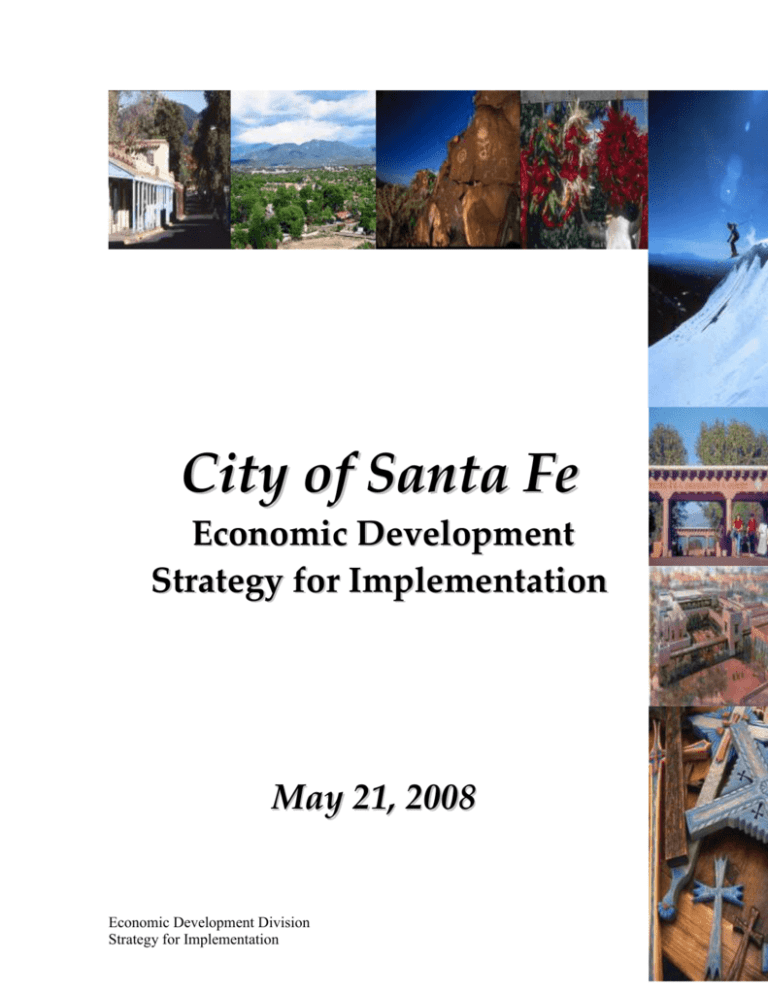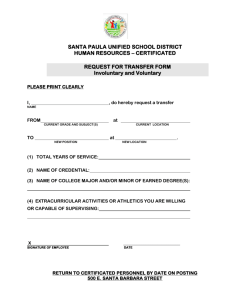ED Strategy for Implementation
advertisement

City of Santa Fe Economic Development Strategy for Implementation Ma y 2 1 , 2 0 0 8 Economic Development Division Strategy for Implementation 1 ECONOMIC DEVELOPMENT DIVISION Strategy for Implementation Table of Contents Mission Objectives Background Desired Outcomes p. 3 p. 3 p. 3 p. 3-4 Division Work p. 4-5 Methodology Goals and Measures Targeted Sectors p. 6 p. 6 p. 6 Process for Evaluating Projects p. 9-13 Requests for Proposals p. 13-14 Definitions p. 15-17 Diagrams Venture Capital Portfolio Target Industry Evaluation Chart City Values Filter Charter Project/Proposal Evaluation Flow Diagram p. p. p. p. Economic Development Division Strategy for Implementation 18 11 12 13 2 ECONOMIC DEVELOPMENT DIVISION Strategy for Implementation Mission: The mission of the Economic Development (ED) Division of the City of Santa Fe is to achieve long-term sustainable and focused economic growth by building a diverse, innovative economy with high-wage, high-impact jobs that provide opportunity and prosperity for the City’s residents, businesses and entrepreneurs. Objectives: -Diversify the Santa Fe Economy with an emphasis on high wage jobs1 and career paths. -Pursue overall affordability where local wages can support living in Santa Fe (reduce leakage2). -Bolster Santa Fe’s leadership position and/or potential in innovation. Background: More than four years ago Angelou Economics produced a report for “Cultivating Santa Fe’s Future Economy.” The implementation strategies in this plan are principally derived from that report. In order to effectively institute the recommendations contained in the Angelou Plan the Economic Development Division has worked to outline a process for vetting potential projects. The process is designed to be fair, easily understood and transparent to members of the community. Angelou Economics calls for the plan to be a ‘living document,’ and updated as conditions change. To that end, the Economic Development Division has held a series of key informant interviews and a series of professionally facilitated seminar meetings with input from members of the local business and economic community. The values and priorities outlined in this implementation plan were discussed and approved by attendees at these meetings. The implementation plan is designed to be driven by measurable, achievable outcomes in several of the target industries identified in the Angelou Plan. Desired Outcomes: The Economic Development Division will work to foster a creative and innovative cultural economy. Specific economic goals that have been identified are as follows: Economic Development Division Strategy for Implementation 3 Create and attract a greater number of high-wage jobs. This will not be to the exclusion of supporting emerging business opportunities in focused sectors that would lead to high wage jobs, but may not start out with high paying jobs. This will give more of Santa Fe’s population the ability to live and work in the community. Ensure that Santa Fe has a skilled and competitive workforce to support innovation and key economic base jobs3 and primary industries4. This includes creating and expanding accessible career paths for local youth. Economic base jobs and primary industries are jobs and industries that derive fifty percent or more of their sales from outside of New Mexico and thus expand the local economy. Recruit and retain local talent by making professional opportunities in the area available and better understood in the community. Improve the climate for doing business in Santa Fe. This includes streamlining the processes of permitting, licensing and other regulatory requirements. The ED division also intends to celebrate innovation and success in leading local businesses. Improve the business infrastructure5 in Santa Fe. This means working regionally to ensure easy, low-cost access to services, utilities, transportation and other key means of support for success in business and community development. Develop stronger working partnerships in the region. This means actively engaging key partners in projects and initiatives on a regular basis in order to maximize community input, expertise, support and communication. Promote a green and sustainable Santa Fe. o Actively promote and stimulate businesses and services consistent with the Sustainable Santa Fe Plan. This will include clean renewable energy, water conservation and waste reduction technologies. o Promote and support projects, developments, and initiatives with sustainable infrastructure6 and that are consistent with the Sustainable Santa Fe Plan. o Cultivate and work to develop a green collar workforce7 to support the clean renewable energy industry as well as both the new and retrofitting of buildings, sites and infrastructure to be more sustainable. Division Work: Staff will work consistently with partners on a regional and collaborative approach to economic development. The Chamber of Commerce, Santa Fe Business Alliance, Santa Fe County, the Museum Foundation of New Mexico, Creative Santa Fe, the Santa Fe Community College, SCORE, the Santa Fe incubator and local venture capital firms will all be key partnerships to maintain and strengthen. A responsive, cooperative, customer service oriented approach will be the guiding principle behind all work done by staff. Economic Development Division Strategy for Implementation 4 Staff work will include: Project Management (Site development, workforce training program development, business support program development and management, etc.) Business Retention, Expansion8 and Passive Recruitment9 (Incentive analysis, site location, funding facilitation consultation, strategic assistance, program referral, etc.) Marketing (Outreach, production of collateral materials, workshops, etc.) Actively Soliciting Proposals to meet community needs. (Proposals can come via our partners including the SF Chamber, the SF Alliance, the State Economic Development Department, staff, Councilors or from other sources.) Streamlining Business Processes (Licensing, permitting, etc.) Contract Management (Business support services, advocacy, etc.) Community and Business Relations (Staff will make regular visits to businesses to gain a firsthand understanding of the industries operating in the region and the challenges they face. During these visits staff will promote awareness of City and State economic development opportunities, policies and capabilities.) Staff will visit approximately 50 businesses per year or approximately two businesses per week to discuss potential business development resources with each company. The resources that will be discussed will be but not limited to alternative financing programs (i.e. City’s Small Business Loan Fund), technical assistance programs (i.e. SF Incubator, SCORE and SBDC programs) and State incentives. Staff will provide a quarterly report containing the following information: Number of Companies Visited Size of Portfolio (Number of Potential Company Expansions, Start-ups and Recruitments) Number of Companies Expanded, Started or Recruited Overview of Companies Expanded in Target Sectors, Number of Jobs, Average Wage and Capital Investment Progress on the Infrastructure Project implementation. The Economic Development Division will take a proactive role in engaging a wide range of regional partners in collaborative efforts to benefit the economy. Emphasis will be placed on getting the right partners to cooperate on each project so that work can be focused on achieving measurable outcomes. For example, the Santa Fe Community College will be a key partner in workforce development and the Santa Fe Chamber of Commerce will be a key partner in business development. Economic Development Division Strategy for Implementation 5 Methodology: The implementation strategy outlines a process for evaluating projects and proposals that meet agreed upon Economic Development Goals. Staff work will be focused along these guidelines: o The Economic Development Division will focus efforts in a few strategic areas in order to effectively use limited resources. Projects will be outcome driven10 with an emphasis on getting the greatest return for the investment of City resources. o Work will be focused along three tracks – business development, workforce development and site & infrastructure development. o Staff will work to streamline the process of providing services. Duties and provision of services will be aligned to best utilize resources, time and knowledge of staff. o Significant effort will be made to provide good customer service and communication. The Division will be accessible to the community and work to ensure clear communication. o Economic development activities will be regionally oriented with an emphasis on working in partnerships. Anticipated partners will include organizations such as the State of NM, the New Mexico Economic Development Partnership, the Santa Fe Community College, Santa Fe County, the Santa Fe Chamber of Commerce, the Santa Fe Alliance and the Santa Fe Incubator. o The portfolio of projects will be organized with an investment/venture capital approach11. The portfolio will endeavor to balance safe bets and risky bets with an understanding that risky projects have a greater chance of failure but may yield the greatest returns. It is expected that applications for economic development projects, which may or may not solicit funding from the Economic Development fund, will be made throughout the year. All projects will be evaluated within the context of the current portfolio, as well as by taking into consideration pending applications. As staff will be working consistently with potential applications, there will be some preliminary assessment of where new applications will fall within the portfolio management spectrum. It is expected that the investment by the City will fall largely into projects with a high probability of success and efficient use of resources. To manage this portfolio, staff will work closely with projects and continually assess their progress toward meeting agreed upon objectives. Economic Development Division Strategy for Implementation 6 Venture Capital Portfolio Resource = Staff time and effort, ED funds, City incentives, etc. High Probability of Success Knowledge Based Project Arts & Culture Project Solar Project Resource Intensive Media Project Resource Efficient Technology Project Low Probability of Success o Projects will be outcome driven and aligned with SMART Goals whenever possible. That is, goals that are - Specific, Measurable (data), Aggressive but Achievable, Relevant to Mission, and Timebound (not just open ended). o During the working period and upon completion, each project will be assessed in order to make adjustments and improve outcomes. There will be a continuous feedback loop where project impact, strengths and weaknesses will be analyzed and any necessary corrections will be made. Goals & Measures: The goals and measures will be cumulative and cover a three year period. 1) Facilitate and assist in the creation of 900 high wage, economic base jobs (see definitions). Economic Development Division Strategy for Implementation 7 2) Facilitate the creation of 36 business expansions, startups, retention or recruitments to the Santa Fe region. 3) Increase the average wage in the Santa Fe region from $14.90 per hour to $15.90. This approach acknowledges and emerging trend in employment where employees contract to work on specific projects and may not be in salaried positions. 4) Complete or develop at least one infrastructure project per year. For example, an Arts & Cultural District12, Mainstreet Program13, telecommunications network plan, implementation of an Airport Master Plan, and expansion of solar industry capacity. 5) Facilitate and assist with the increase and/or creation of workforce career pathways and skill levels in targeted industry sectors by developing up to two workforce development programs. This will largely be accomplished by working with our local partners, including the SFCC, Santa Fe Public School District and the Northern Area Workforce Development Board. Targeted Sectors for Growth and Development: Economic development activities will focus on targeted industries identified in the Angelou Plan and refined through the recent economic development seminar meetings. Targeted sectors are identified as follows: Media (Film, Publishing, Journalism, Video Game Production, etc.) Green – Consistent with Sustainable Santa Fe Plan and including: Clean renewable energy (with a focus on the solar industry), water conservation, waste reduction technologies and outdoor and recreational activities and equipment. Technology (Biotech, Nanotech, Software design, etc.) Knowledge Based Enterprise (Research and Development, Think Tanks, Financial Services, Consulting, Public Policy, etc.) Arts & Culture (Artisans, Fine Artists, and Cultural Heritage as described in the City’s Cultural, Arts and Tourism Plan.) Request for Proposal Versus Unsolicited Proposals: The Economic Development Division anticipates two processes to generate projects and programs that will meet the Economic Development Implementation Strategy. These two processes reflect the nature of economic development work. The first will rely on generating proposals in response to an annual request for proposal and the second will allow for unsolicited proposals for economic development projects that may emerge during the course of a year. 1. Request for Proposals – Each year the staff will prepare a Request for Proposal (RFP) for services and/or programs that support local economic development efforts. Typically, these RFP’s will allow for three years worth of contracting, subject to funding availability and successfully meeting the agreed upon outcomes Economic Development Division Strategy for Implementation 8 for a particular Scope of Work. These types of RFP’s will focus on support services, such as those provided through the Santa Fe Incubator and SCORE and the management of the Santa Fe Loan Fund. These are services paid through the Economic Development Fund, which uses the 1% of the State’s share of the GRT as its funding source. 2. Unsolicited Proposals – At any time, proposals may be submitted for projects that must meet the Local Economic Development Act. Such proposals may request funding through the EDF, below market rate rent for buildings and/or other types of incentives. These incentives may include fast tracking through the City’s various review processes and/or favorable financing or other incentives such as Industrial Revenue Bonds (IRB’s). Staff will work closely with organizations and/or entities seeking such support well in advance of an actual application for assistance. The process for evaluating these applications is the same as for those submitting proposals in response to a Request for Proposal. Process for Evaluating Projects, Proposals and Incentives: The process is designed to make project, proposal and incentive evaluation fast, easily understandable, transparent and accessible to the community. It is a way for staff to fully vet projects or incentive proposals and thereby determine the allocation of money, staff time and effort. The following illustrates how the evaluation process will consider multiple projects and focus efforts to those with the best potential outcome. Stage 1 – Economic Development Target and Values Assessment Economic Development Division Strategy for Implementation 9 Staff will assess the project/proposal by applying the following values filters: A. Environmental Footprint14 (water, power, emissions etc) B. Wages and Benefits15 (Is it possible to live and work in Santa Fe?) C. Innovative Position/Potential16 D. Local17 (Does it fit with the City Different? Does it enhance the cultural fabric? Is it homegrown? Doest it provide positive impacts to local Santa Fe residents) The project targets will be assessed qualitatively using a check mark system. When reviewing the project, each target met will be assessed and checked in the project evaluation chart below. Stage 2 – Initial Business Plan/Proposal Review Staff will meet with representatives of a project/proposal and work to understand the proposed business plan and/or proposal, identify potential problems, discuss potential resources, and answer any questions. Staff will perform an initial evaluation to ascertain the plan strengths and weaknesses. Financial solvency, community need, growth potential and environmental footprint will also be evaluated. Staff will work with representatives to match them with appropriate economic development resources. Staff will also ensure that all proposals are in compliance with the State’s enabling legislation the Local Economic Development Act18 which in Santa Fe is the Economic Development Plan Ordinance. Cost-Benefit Analysis: Economic Development projects will also include a costbenefit analysis as required by the city’s (11-11.1) Economic Development Plan Ordinance. In accordance with the Economic Development Plan ordinance, the projects and/or incentive proposal must provide a return on investment over a 10year period that recoups the value of the assistance provided by the city to the project. The return on investment shall be of value and may be paid in money, inkind services, jobs, expanded tax base, property or other thing or service of value for the expansion or improvement of the economy. The cost-benefit analysis or impact analysis will measure both direct and indirect impacts in accordance with 11-11.9 of the Economic Development Plan ordinance which will include but is not limited to the following: Jobs Pay scale of jobs Anticipated impact of project on local tax base Anticipated impact of project on local school system Economic Development Division Strategy for Implementation 10 Assistance in providing affordable housing to employees or to the community at large may qualify If a proposal requires funds of less than $30,000 staff will make a recommendation to the City Manager and move forward. Quarterly reports will be made to the BQL on these projects. If the proposal requires funds of more than $30,000 staff will refer the project/proposal to the Economic Development Review Sub-Committee (EDRC) with a recommendation. Staff will utilize the following target industry evaluation chart to map the benefits and impacts of a project/proposal, The system of checkmarks is designed to provide a quick overview of the project’s applicability to the target industry areas and the types of program and/or assistance needed for a particular business plan: Target Industry Evaluation Chart: Business Development Workforce Development Sites & Infrastructure Targets Media Green Tech Knowledge Based Enterprise Arts & Culture The project will also be assessed whether it meets the city’s values as defined in the city values filters chart below. The values will be assessed using the following quantitative measures on a scale of 1-3 where three is exceeds values and 1 does not meet values. Use of this scale will provide a quantitative comparison between projects and provide an initial assessment of a proposed project’s ability to address agreed upon local values: 3- Exceeds Values Criteria 2 – Meets Values Criteria 1 – Does Not Meet Values Criteria Economic Development Division Strategy for Implementation 11 City’s Values Filters Chart: Business Development Workforce Development Sites & Infrastructure Values Low Environmental Footprint High Wages & Benefits Innovative Position/Potential Local Stage 3 – EDRC Review The EDRC will review the staff recommendation and assess the project/proposal against the values filters, desired outcomes and financial feasibility. The EDRC will then make its recommendation to the Business and Quality of Life Committee (BQL). Stage 4 – BQL Review BQL will review the EDRC recommendation and assess the project/proposal against the values filters19, desired outcomes and financial feasibility. BQL will then make its recommendation to the City Council OR reject the project/proposal. Stage 5 – Council Review The City Council will assess the project/proposal against the values filters, desired outcomes and financial feasibility. The City Council will approve or reject the project/proposal. Economic Development Division Strategy for Implementation 12 Project/Proposal Evaluation Flow Diagram Requests for Proposals: RFPs will be focused on getting results rather than outlining step by step procedures. This will allow for maximum input and creativity from RFP responders. Staff will evaluate RFP responses according to how well each proposal will meet the desired economic development outcomes. The timeline for RFPs to be issued will be no more than 30 days after approval of the implementation plan by City Council. The RFPs will be reviewed and evaluated by a committee as required under the City’s procurement code. The RFPs will be evaluated on how the respondents will meet the desired outcomes. RFP awardees will receive a contract for one year and two one year extensions. Staff will work with RFP respondents to get more information, clarify how the work will be done and what outcomes need to be reached. For RFPs greater than $30,000 respondents will present their proposal to the EDRC. Staff will provide the EDRC with a funding recommendation. Economic Development Division Strategy for Implementation 13 Staff will administer contracts according to the scope of work and timeframe agreed upon in each contract. If necessary, at the discretion of the Division Director and Department Director, timeframe extensions and contract revisions may be made. Economic Development Division Strategy for Implementation 14 DEFINITIONS High Wage Jobs – In the State of New Mexico these are defined as jobs that pay a salary of $40,000 and above. 1 Leakage – The loss of revenue in taxes and spending and the loss of talent that occurs when people cannot afford to work and live in the community. 2 3 Economic Base Jobs - Economic base jobs are jobs in primary industries. An economic base job is any job that produces a product or service that is sold outside the community and thus brings in outside money. Most economists believe that the economic base job is the most important factor to a healthy economy. Primary Industries – Primary industries are defined on the same principle as economic base jobs. They are industries that derive fifty percent or more of their sales from outside of New Mexico and thus bring in new money expand the local economy. Businesses that bring in outside money are called primary industries, and they produce the coveted “economic base” jobs. 4 Business Infrastructure – The basic facilities, services, and installations needed for the effective functioning of businesses in the area. This can include transportation and communications systems, water and power lines, as well as public institutions including schools and post offices. 5 Sustainable Infrastructure – Basic facilities, services and installations which take care of the needs of the present generation without compromising the needs of future generations. 6 Green Collar Workforce – A workforce employed in the environmental segment of the economy. Green collar workers include professionals such as conservation movement workers, environmental consultants, environmental or biological systems engineers, LEED’s certified building architects, holistic passive solar building designers, solar energy and wind energy engineers, alternative energy vehicle engineers, organic farmers, environmental lawyers, ecology educators, and eco-technology workers. They also include vocational or trade-level employment: electricians who install solar panels, plumbers who install solar water heaters, and construction workers who build energy-efficient LEED certifed buildings, wind power farms, or other clean, renewable, sustainable future energy developments. 7 Business Retention and Expansion – The retention of local businesses located in the Santa Fe region that may leave the community. Expansion is assisting local businesses in the Santa Fe region in growing their operations, employment or sales which results in more jobs and capital investment in Santa Fe. 8 Economic Development Division Strategy for Implementation 15 Passive Recruitment – Responding to inquiries and opportunities from businesses considering locating in the Santa Fe area but not actively marketing businesses to locate in Santa Fe from outside of Santa Fe. 9 Outcome Driven – Guided by what results are or can be achieved rather than the method or process of working towards results. 10 11Investment/Venture Capital Approach - An approach similar to that taken by investment and venture capital managers wherein resources are balanced between calculated risky and safe ventures where safe ventures produces lower returns on investment and higher risk ventures produces higher returns on investment. Investments are also spread across different areas to achieve stability through diversity. Arts & Cultural District – A State program administered by the Mainstreet program which is designed to enhance local economic development opportunities, in designated districts, by placing an emphasis on indigenous arts and culture. Applying communities develop a plan to support, develop and enhance the selected district’s arts and cultural opportunities as a niche for economic development. 12 13 Mainstreet Program - New Mexico’s MainStreet Program is a grassroots economic development program that assists communities in revitalizing their traditional commercial neighborhoods. Mainstreet works to create an economically viable business environment while preserving local cultural and historic resources. Environmental Footprint – A project/proposal’s potential impact on the local environment and ecology including water and power use, emissions, amount of solid waste generated, impact on local vegetation and wildlife and traffic impact. 14 Wages and Benefits – A project/proposal’s potential impact on or offering of employee pay and benefits including but not limited to retirement, healthcare, educational benefits, flexible scheduling, community service, support and involvement. 15 Innovation Position/Potential – A project/proposal’s potential impact on Santa Fe’s innovation in an industry or the possibility of increasing the creative and/or innovative impact on the industry. 16 Local – A project/proposal’s homegrown origin or its impact on the cultural fabric, identity i.e. how it fits with the ‘City Different,’ and/or provides positive economic impacts to residents of Santa Fe, 17 Local Economic Development Act – The State of New Mexico’s enabling legislation which allows local governments the ability to use public money for private enterprises (including non-profits) in the form of land, building and infrastructure in order to foster economic development. This legislation allows public investment in private enterprises without violating the anti-donation clause of the New Mexico State Constitution 18 Economic Development Division Strategy for Implementation 16 Values Filters – The method for evaluating projects according to what is important to the local community’s priorities. 19 Economic Development Division Strategy for Implementation 17 Venture Capital Portfolio Resource = Staff time and effort, ED funds, City incentives, etc. High Probability of Success Knowledge Based Project Arts & Culture Project Solar Project Resource Intensive Media Project Resource Efficient Technology Project Low Probability of Success Economic Development Division Strategy for Implementation 18






